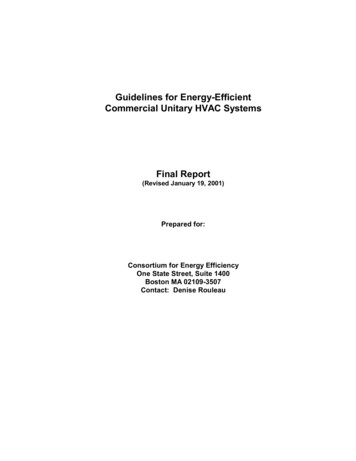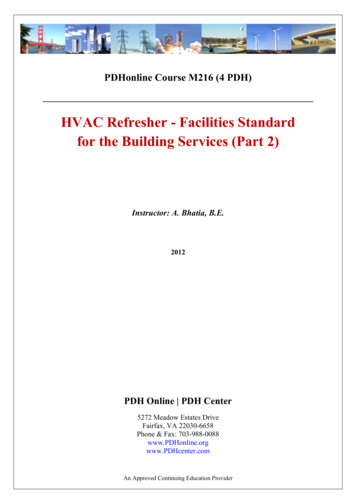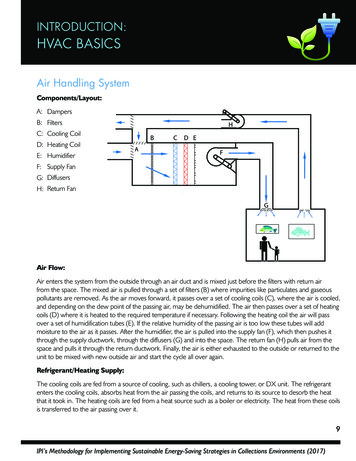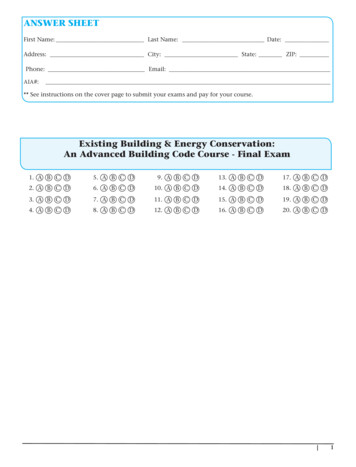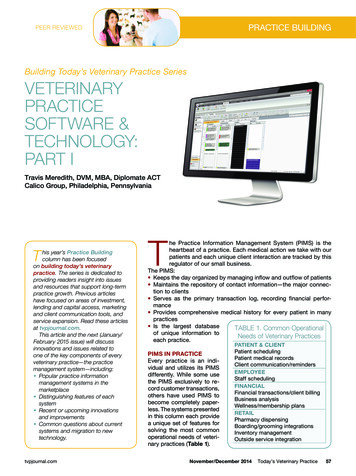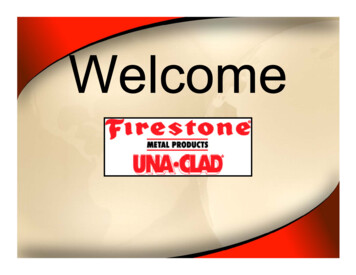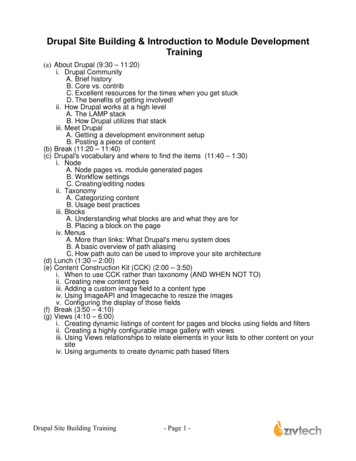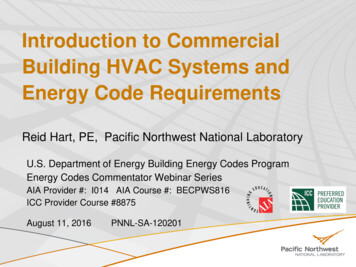
Transcription
Introduction to CommercialBuilding HVAC Systems andEnergy Code RequirementsReid Hart, PE, Pacific Northwest National LaboratoryU.S. Department of Energy Building Energy Codes ProgramEnergy Codes Commentator Webinar SeriesAIA Provider #: I014 AIA Course #: BECPWS816ICC Provider Course #8875August 11, 2016PNNL-SA-120201
Course Description andLearning ObjectivesOverview of common commercial building Heating, Ventilating, andAir-conditioning (HVAC) systems as they relate to energy coderequirements. Learn about the most common HVAC systems andequipment, along with energy-related components and controls.Several important energy code requirements will be reviewed,including what to look for in the field or on plans.Learning Objectives:1. Identify common HVAC system types.2. Identify important HVAC controls, includingeconomizers.3. Name high impact energy code items related toHVAC equipment and controls.4. List the steps in verifying fan power calculations.Building Energy Codes Program2
OutlineHVAC system basicsBasic controls that save energyOutside air economizersReferences to energy codesections in this presentationare to the commercialprovisions of the2015 International EnergyConservation Code (IECC).Fan energy limitsComplex systems:Central plantSecondary HVAC systemsHigh energy impact complex controlsHydronic system controlsSimilar requirements mayexist in the 2012 IECC orASHRAE Standard 90.1-2013,but section numbers will bedifferent, and there will beslight variation inrequirements.HVAC high efficiency optionBuilding Energy Codes Program3
HVACSystemBasicsSource: https://en.wikipedia.org/wiki/Air handlerBuilding Energy Codes Program4
Basic Purpose of HVACAir-conditioning for thermal and humidity nSource: ASHRAE Fundamentals Handbook 2013VentilationIntroduction of required outside airInternational Mechanical Code (IMC)Chapter 4 : VentilationASHRAE Standard 62.1Filtration of recirculated airExhaust of undesirable air (toilet, kitchen, lab exhaust)Air movement in spaceSpace pressurizationControl infiltrationMakeup of exhausted airBuilding Energy Codes Program5
Heat Gain vs. Heat Loss (Winter)Heat GainsSolar thru windows/wallsSummer transfer/infiltrationInternalHeat LossAir Leaks (Infiltration)Transfer (conduction &radiant) throughElectric Use, LightingBody HeatWallsRoofsFloorWindowsDifference supplied byHeater orAir ConditionerBuilding Energy Codes Program6
Air ConditioningTwo general types of air conditioning (cooling)Refrigerant-based: refrigeration cycle moves heat from one space(indoors) to another (outdoors)Refrigerant evaporates and condenses continuously within cycleRefrigerant has a low boiling point, making it ideal for HVAC systemsSimilar to car AC systemNon-refrigerant: evaporative coolingSimple vs. Complex (no longer a code distinction in 2015 IECC)Simple systems often use direct expansion coils or heatDirectly use refrigerant to cool or heat airGas, oil or electricity in a furnace to heat airSimple systems usually serve one zone with direct controlComplex systems transfer heating and cooling to secondary unitsCooling: the refrigerant is in the chiller and chilled water goes to cooling coilsHeating: a boiler generates hot water or steam that is piped to heating coilsComplex systems usually serve multiple zonesBuilding Energy Codes Program7
System Capacity SizingVerify that cooling and heatingcapacity sizing (load calculations)have been completed (C403.2.1)Verify that equipment is notunreasonably over-sized (C403.2.2)Why?For simple constant volumeequipment, fan energy use will besignificantly higher because fans mustrun constantly to provide ventilationFor larger multiple-zone VAV systems,fan and reheat energy use will behigher because the turndown ofoversized zone boxes is limited.Source: RoadTrafficSigns.comBuilding Energy Codes Program8
VentilatingTwo types:Mechanical ventilationFans pull outside air into building for ventilationVentilation includes both outside air and recirculated airRequirements are available for minimum outside air, based on occupancy,floor area and number of occupants (See the International Mechanical Code(IMC) Chapter 4 or ASHRAE Standard 62.1)Natural ventilationNo fansBuilding Energy Codes Program9
Simple HVAC SystemsPackage UnitsThru-wall air conditionerPackage Terminal Air Conditioner (PTAC)Package Terminal Heat Pump (PTHP)UnitaryAir conditionerFurnaceHeat PumpsPackaged, split, mini-splitVariable refrigerant flow (VRF)Source: reptw092h3g 9000btu PTAC wall air conditioner heat pump.htmSource: https://en.wikipedia.org/wiki/Air handlerBuilding Energy Codes Program10
Packaged Rooftop Cooling UnitPackaged Unit (DX cooling) Outside Air VentilationDX (DirectExpansion)CoolingCoilAirFiltersMin OA(Outside )MixedAirRoomThermostatBuilding Energy Codes ProgramSupplyFanSA(SupplyAir) orDA(DischargeAir)11
Refrigeration cycleCompressor uses electric power toincrease pressure of refrigerantCondenser “cools” refrigerant,refrigerant changes from gas toliquid. Removes thermal energyfrom systemExpansion device lowers pressureEvaporator (cooling coil) “heats”refrigerant and cools air, refrigerantchanges back to gas. Adds thermalenergy to systemPower: compressor, condenser fan,furnace blower, furnace in heatingmodeBuilding Energy Codes Program12
Variable Refrigerant Flow (VRF)Could be single zone (mini-split)Or multiple zone (VRF System)Just a complex heat pump, serving multiple zonesSource: ochanges/heatpump/Building Energy Codes Program13
Things to Check in the Energy CodeEquipment EfficiencyTables in C403.2.3Separate tables for each typeDifferent efficiency ratingsHigher is generally betterFurnace: AFUE v. EtCooling: SEER vs. EER vs. IEER vs. COPHeat pump heating: HSPF vs. COPIf multiple requirements: must meet allEquipment Efficiency ImportanceMost equipment must meet manufacturing requirementsExceptions:Regional requirementsOld inventoryVariable Refrigerant Flow (VRF) system efficiency is not covered in 2015IECC, but is in ASHRAE Standard 90.1-2013Building Energy Codes Program14
Basic Controlsthat SaveEnergyBuilding Energy Codes Program15
Top of the ChartsMost impactful basic HVAC control measures*Snow and ice melt heater controlTemperature setback schedulingFull 5 degree thermostat deadbandEconomizer controlsAdditional impactful complex HVAC control measures Photo courtesy of Ken Baker, K energyFull 5 degree thermostat deadbandLimits on simultaneous heating and cooling (VAV reheat)VAV ventilation optimizationSupply air temperature & fan static reset controlsOther impactful HVAC measures*Exterior ductwork insulation (C403.2.9)Fan power within limitsProper equipment sizingSnow and icemelt heaterswill use a largeamount ofenergy if notproperly andautomaticallycontrolled!*Rosenberg, M., Hart, R., Athalye, R., Zhang, J., Wang, W., and Liu, B. (2016). “An Approach to Assessing Potential Energy CostSavings from Increased Energy Code Compliance in Commercial Buildings.” PNNL for al/technical reports/PNNL-24979.pdfBuilding Energy Codes Program16
Temperature Setback SchedulingSimple control systemsProgrammable thermostatsSeven different daily schedules/weekManual overrideOccupant sensor is an alternativeDDC (direct digital control) systemsCentral scheduling of all unitsOptimum start activatedSource: n-to-building-automation-system-bas.htmlBuilding Energy Codes ProgramEnergy Myth:Setback does not save energybecause it takes so long towarm up in the morningNot true:Savings can be 5%-20% ofHVAC energy Use17
Full 5 Degree Temperature DeadbandA most significant controlfeature is temperaturedeadbandIf heating is set at 70 F, thencooling should be 75 FShould be the found conditionduring an inspectionWhy?Source: ammable-thermostat/Simple systems can fight eachother in open office areasVAV systems have excessivereheat if settings are too tightEnergy Star recommendedfactory default setpoints of:Heating 70 FCooling 78 FSource: www.AutomatedLogic.comBuilding Energy Codes Program18
Outside AirEconomizersBuilding Energy Codes Program19
HVAC – Economizers “Free Cooling”Quantity of OSA: Meet Minimum Ventilation RequirementEconomizer Function: Flush out building heat with cool outside airEconomizerVentilation AirBuilding Energy Codes Program20
Packaged Rooftop Cooling UnitPackaged Unit (DX cooling) Outside Air VentilationDX (DirectExpansion)CoolingCoilAirFiltersMin OA(Outside )MixedAirRoomThermostatBuilding Energy Codes ProgramSupplyFanSA(SupplyAir) orDA(DischargeAir)21
Basic OSA Economizer Idea22Building Energy Codes Program22
Economizer ComponentsDampers (not shown)Damper MotorsMAT/DAT sensorsSolid State ControllerOAT/RAT sensorsDry bulbEnthalpyCode econo requirementsOSA ductwork large enoughRelief damper providedIntegratedOperates with compressorCoordinated with cooling(Honeywell shown, often basis of OEM brands, out there for 30 years)Building Energy Codes Program23
OSA Economizer Savings1600 Executive Pkwy.15 min data0:15 1:00 1:45 2:30 3:15 4:00 4:45 5:30 6:15 7:00 7:45 8:30 9:15 17:3018:1519:0019:4520:3021:1522:00Region of Savings12022:4523:30601005080406030kWhTemperature / % damper 04050607080910111213Building Energy Codes Program14151617181920212224
Economizer Savings – It’s in the Settings!High limit needed to turn off economizer when not beneficial!Fixed dry bulb cuts off above 75 F, 70 F, or 65 F—depending on CZDifferential dry bulb cuts off when OSA RADifferential DB no longer allowed in Climate Zones 1A, 2A, 3A, 4AFixed or differential enthalpy high limit adjusts for humidity of OSAEnthalpy requires a paired dry bulb high limit in event of sensor inaccuracyEconomizer savingsTheoretically 60%Low high limitsettings: 10%-20%“Premium economizer” Code economizerSettings correctRelief airIntegratedCheckout & FDDBuilding Energy Codes Program25
Economizer: Things to Check in the Energy CodeDamper and ductworkFull sized OSA damperRelief damper; powered orbarometricHigh limit or changeoversetting (C403.3.3.3)Proper setpoint a mystery tomost field techniciansSettings typically too low;reducing or eliminatingsavings (55 F vs. 75 F)High Limit Set pertable C403.3.1.1.3(2)for climate zoneSource: y.aspx?cat HonECC Catalog&category W7459&catpath 1.1.2.1.14Source: http://www.zipeconomizer.com/New 2015 IECC Fault Detection &Diagnostic (FDD) Requirements:(C403.2.4.7) Sensors; faults & setup.The controller above does not meetthe new m/products/Jade-Economizer26Building Energy Codes Program
Top of the ChartsMost impactful basic HVAC control measures*Snow and ice melt heater controlTemperature setback schedulingFull 5 degree thermostat deadbandEconomizer controlsAdditional impactful complex HVAC control measureshttp://www.rockwoolasia.com/products and solutions/Full 5 degree thermostat deadbandu/2011.construction/9794/HVAC/Internal duct linerLimits on simultaneous heating and cooling (VAV reheat)VAV ventilation optimizationDuctwork in attics oroutside the buildingSupply air temperature & fan static reset controls(exposed on the roof)Other impactful HVAC measures*requires moreExterior ductwork insulation (C403.2.9)insulation:Fan power within limitsR-8 in CZ 1-4R-12 in CZ 5-8Proper equipment sizing*Rosenberg, M., Hart, R., Athalye, R., Zhang, J., Wang, W., and Liu, B. (2016). “An Approach to Assessing Potential Energy CostSavings from Increased Energy Code Compliance in Commercial Buildings.” PNNL for al/technical reports/PNNL-24979.pdfBuilding Energy Codes Program27
Fan EnergyLimitsBuilding Energy Codes Program28
Losses occur for eachconversion of energyWire orEfficiency:80% Losses of20%Fan BeltLosses6%Air FlowOverall Fan System EfficiencyMultiple Conversions Multiple LossesFanEfficiency:70% Losses of30%Meter kWMotor Input kWMotor Shaft kWFan Shaft kWAir kW WorkLossesOverall system efficiency [5.0 kW work] / [9.65 kW in] 52%The energy code manages overalllarge fan efficiency by limitingnameplate motor hp or fan bhpper cfm of airflow supplied.Building Energy Codes Program29
Fan Power LimitHVAC systems with total fan motor nameplate hp 5hpEither meet nameplate horsepower or fan bhp (C403.2.12.1)Based on supply cfm with pressure adjustmentsBuilding Energy Codes Program30
COMcheck: Mechanical - Fan SystemsDetermines Fan Power Limitations compliance for each fan systemMotor nameplate HP and brake HPBrake HP includes pressure drop credits as applicableInclude all supply, return and exhaust fans in each systemMay have to allocate partial exhaust to each systemDo not need to enter duplicate systems repetitivelyBuilding Energy Codes Program31
Variable Speed DrivesReducing fan or pump speed savesenergy at partial flowFans in hydronic and multiple zonesystems must be variable flow (C403.4.1)Dx 65 MBH or more: 2-speedCHW ¼ HP: VSDSo most chilled water (CHW) fans musthave variable speed drivesFor example, 80% flow results in a 50%power reductionA variable speed drive should be evidentat the site or on the specificationsSource: https://en.wikipedia.org/wiki/Variable-frequency driveBuilding Energy Codes Program32
ComplexSystems:CentralPlantSource: cement-a-
Building HVAC Systems and Energy Code Requirements Reid Hart, PE, Pacific Northwest National Laboratory U.S. Department of Energy Building Energy Codes Program . Energy Codes Commentator Webinar Series . AIA Provider #: I014 AIA Course #: BECPWS816 . ICC Provider Course #8875 . August 11, 2016 PNNL-SA-120201 . Course Description and Learning Objectives Overview of common
